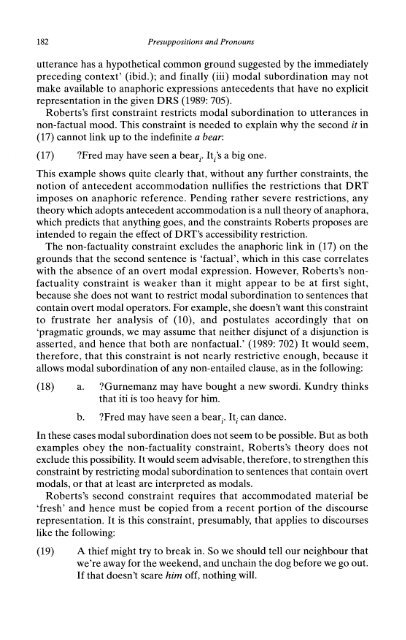Presuppositions and Pronouns - Nijmegen Centre for Semantics
Presuppositions and Pronouns - Nijmegen Centre for Semantics
Presuppositions and Pronouns - Nijmegen Centre for Semantics
Create successful ePaper yourself
Turn your PDF publications into a flip-book with our unique Google optimized e-Paper software.
182 <strong>Presuppositions</strong> <strong>and</strong> <strong>Pronouns</strong><br />
utterance has a hypothetical common ground suggested by the immediately<br />
preceding context' (ibid.); <strong>and</strong> finally (iii) modal subordination may not<br />
make available to anaphoric expressions antecedents that have no explicit<br />
representation in the given DRS (1989: 705).<br />
Roberts's first constraint restricts modal subordination to utterances in<br />
non-factual mood. This constraint is needed to explain why the second it in<br />
(17) cannot link up to the indefinite a bear. bear:<br />
(17) Fred may have seen a bear^. i . It/s It-'s a big one.<br />
This example shows quite clearly that, without any further constraints, the<br />
notion of antecedent accommodation nullifies the restrictions that DRT<br />
imposes on anaphoric reference. Pending rather severe restrictions, any<br />
theory which adopts antecedent accommodation is a null theory of anaphora,<br />
which predicts that anything goes, <strong>and</strong> the constraints Roberts proposes are<br />
intended to regain the effect of DRT's accessibility restriction.<br />
The non-factuality constraint excludes the anaphoric link in (17) on the<br />
grounds that the second sentence is 'factual', which in this case correlates<br />
with the absence of an overt modal expression. However, Roberts's non-<br />
nonfactuality<br />
constraint is weaker than it might appear to be at first sight,<br />
because she does not want to restrict modal subordination to sentences that<br />
contain overt modal operators. For example, she doesn't want this constraint<br />
to frustrate her analysis of (10), <strong>and</strong> postulates accordingly that on<br />
'pragmatic grounds, we may assume that neither disjunct of a disjunction is<br />
asserted, <strong>and</strong> hence that both are nonfactual.' (1989: 702) It would seem,<br />
there<strong>for</strong>e, that this constraint is not nearly restrictive enough, because it<br />
allows modal subordination of any non-entailed clause, as in the following:<br />
(18) a. Gurnemanz may have bought a new swordi. Kundry thinks<br />
that iti is too heavy <strong>for</strong> him.<br />
b. Fred may have seen a bear^.. t<br />
Iti It; can dance.<br />
In these cases modal subordination does not seem to be possible. But as both<br />
examples obey the non-factuality constraint, Roberts's theory does not<br />
exclude this possibility. It would seem advisable, there<strong>for</strong>e, to strengthen this<br />
constraint by restricting modal subordination to sentences that contain overt<br />
modals, or that at least are interpreted as modals.<br />
Roberts's second constraint requires that accommodated material be<br />
'fresh' <strong>and</strong> hence must be copied from a recent portion of the discourse<br />
representation. It is this constraint, presumably, that applies to discourses<br />
like the following:<br />
(19) A thief might try to break in. So we should tell our neighbour that<br />
we're away <strong>for</strong> the weekend, <strong>and</strong> unchain the dog be<strong>for</strong>e we go out.<br />
If that doesn't scare him off, nothing will.














